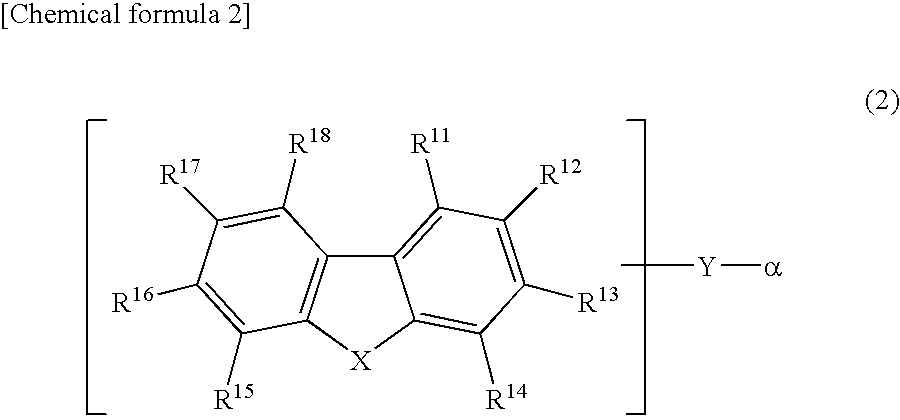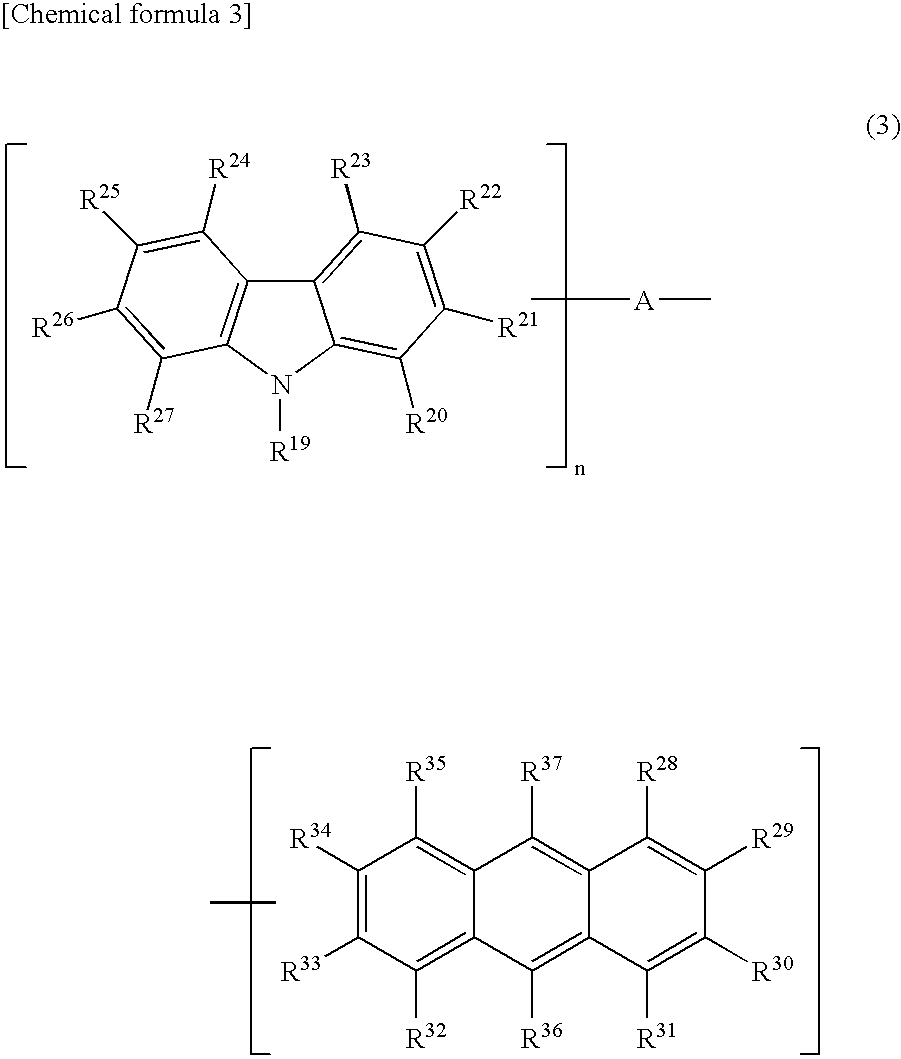Light-Emitting Device Material and Light-Emitting Device
a technology of light-emitting devices and materials, applied in the direction of organic semiconductor devices, discharge tubes/lamp details, group 5/15 element organic compounds, etc., can solve the problems of insufficient durability, and achieve excellent durability, excellent thin film stability, and high luminous efficiency
- Summary
- Abstract
- Description
- Claims
- Application Information
AI Technical Summary
Benefits of technology
Problems solved by technology
Method used
Image
Examples
example 1
A Synthetic Method of a Compound [3]
[0083] A mixed solution of 1 g of 2-tert-butyl-9,10-dibromoanthracene, 1.5 g of 4-dibenzofuranboronic acid, 2.2 g of tripotassium phosphate, 0.33 g of tetrabutylammonium bromide, 5 mg of palladium acetate and 40 ml of dimethylformamide was heated while stirred under nitrogen gas stream at a temperature of 130° C. for 6 hours. After cooling the mixed solution to room temperature, 50 ml of water was injected thereto to extract 100 ml of dichloromethane therefrom. The organic layer was washed twice in 50 ml of water, dried by magnesium sulfate and thereafter concentrated by evaporation. The organic layer was purified by silica gel column chromatography and vacuum dried to obtain 0.6 g of a white crystal. The results of 1H-NMR analysis of the obtained powder are as follows.
[0084]1H-NMR (CDCl3 (d=ppm)): 1.16 (s, 9H), 7.26-7.30 (m, 2H), 7.34-7.44 (m, 7H), 7.57-7.68 (m, 8H), 8.09 (m, 2H), 8.18 (m, 2H)
[0085] This compound [3] was purified by sublimation...
example 2
Synthesis of a Compound [58]
[0086] A solution of 8.5 g of carbazole, 50 g of 1,4-diiodobenzene, 3.9 g of copper powder, 8.43 g of potassium carbonate and 8.66 g of sodium sulfate in 500 ml of nitrobenzene as a solvent was heated while stirred under nitrogen atmosphere at a temperature of 200° C. for 2 days. Thereafter, most of nitrobenzene was distilled out under reduced pressure to thereafter add 400 ml of dichloromethane thereto. The solid was filtered off, thereafter concentrated by evaporation and washed in hexane. The solid was purified by silica gel column chromatography and vacuum dried to thereafter obtain 9.16 g of 1-(4-iodophenyl)carbazole.
[0087] A solution of 12 g of 9-bromoanthracene, 10 g of 4-tert-butylphenylboronic acid, 19.9 g of tripotassium phosphate, 3.02 g of tetrabutylammonium bromide and 106 mg of palladium acetate in 300 ml of dimethylformamide as a solvent was heated while stirred under nitrogen atmosphere at a temperature of 130° C. for 5 hours. After cooli...
example 3
Synthesis of a Compound [84]
[0093] 140 mg of a compound [84] was obtained in the same manner as Example 2 except for replacing 1-(4-iodophenyl) carbazole with 1-(6-trifluoromethanesulfonyloxynaphthalene-2-yl)carbazole. 1H-NMR was not measured by reason of being hardly soluble in commercial heavy hydrogen solvent. This compound [84] was purified by sublimation under a pressure of 1×10−3 Pa at a temperature of approximately 280° C. by using an oil diffusion pump, and thereafter used as a light emitting device material. HPLC purity (area % at a measuring wavelength of 254 nm) was 99.5% before purification by sublimation and 99.9% after purification by sublimation.
PUM
| Property | Measurement | Unit |
|---|---|---|
| Half-life | aaaaa | aaaaa |
| Half-life | aaaaa | aaaaa |
| Half-life | aaaaa | aaaaa |
Abstract
Description
Claims
Application Information
 Login to View More
Login to View More - R&D
- Intellectual Property
- Life Sciences
- Materials
- Tech Scout
- Unparalleled Data Quality
- Higher Quality Content
- 60% Fewer Hallucinations
Browse by: Latest US Patents, China's latest patents, Technical Efficacy Thesaurus, Application Domain, Technology Topic, Popular Technical Reports.
© 2025 PatSnap. All rights reserved.Legal|Privacy policy|Modern Slavery Act Transparency Statement|Sitemap|About US| Contact US: help@patsnap.com



